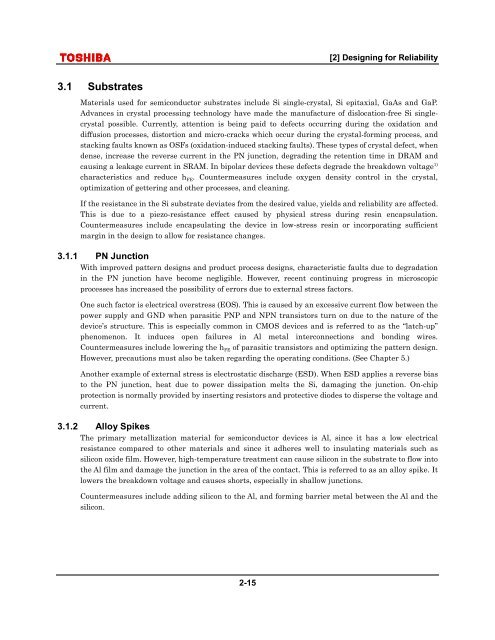1. Basic Concepts in Reliability Design - nl3prc
1. Basic Concepts in Reliability Design - nl3prc
1. Basic Concepts in Reliability Design - nl3prc
You also want an ePaper? Increase the reach of your titles
YUMPU automatically turns print PDFs into web optimized ePapers that Google loves.
[2] <strong>Design</strong><strong>in</strong>g for <strong>Reliability</strong>3.1 SubstratesMaterials used for semiconductor substrates <strong>in</strong>clude Si s<strong>in</strong>gle-crystal, Si epitaxial, GaAs and GaP.Advances <strong>in</strong> crystal process<strong>in</strong>g technology have made the manufacture of dislocation-free Si s<strong>in</strong>glecrystalpossible. Currently, attention is be<strong>in</strong>g paid to defects occurr<strong>in</strong>g dur<strong>in</strong>g the oxidation anddiffusion processes, distortion and micro-cracks which occur dur<strong>in</strong>g the crystal-form<strong>in</strong>g process, andstack<strong>in</strong>g faults known as OSFs (oxidation-<strong>in</strong>duced stack<strong>in</strong>g faults). These types of crystal defect, whendense, <strong>in</strong>crease the reverse current <strong>in</strong> the PN junction, degrad<strong>in</strong>g the retention time <strong>in</strong> DRAM andcaus<strong>in</strong>g a leakage current <strong>in</strong> SRAM. In bipolar devices these defects degrade the breakdown voltage 1)characteristics and reduce h FE . Countermeasures <strong>in</strong>clude oxygen density control <strong>in</strong> the crystal,optimization of getter<strong>in</strong>g and other processes, and clean<strong>in</strong>g.If the resistance <strong>in</strong> the Si substrate deviates from the desired value, yields and reliability are affected.This is due to a piezo-resistance effect caused by physical stress dur<strong>in</strong>g res<strong>in</strong> encapsulation.Countermeasures <strong>in</strong>clude encapsulat<strong>in</strong>g the device <strong>in</strong> low-stress res<strong>in</strong> or <strong>in</strong>corporat<strong>in</strong>g sufficientmarg<strong>in</strong> <strong>in</strong> the design to allow for resistance changes.3.<strong>1.</strong>1 PN JunctionWith improved pattern designs and product process designs, characteristic faults due to degradation<strong>in</strong> the PN junction have become negligible. However, recent cont<strong>in</strong>u<strong>in</strong>g progress <strong>in</strong> microscopicprocesses has <strong>in</strong>creased the possibility of errors due to external stress factors.One such factor is electrical overstress (EOS). This is caused by an excessive current flow between thepower supply and GND when parasitic PNP and NPN transistors turn on due to the nature of thedevice’s structure. This is especially common <strong>in</strong> CMOS devices and is referred to as the “latch-up”phenomenon. It <strong>in</strong>duces open failures <strong>in</strong> Al metal <strong>in</strong>terconnections and bond<strong>in</strong>g wires.Countermeasures <strong>in</strong>clude lower<strong>in</strong>g the h FE of parasitic transistors and optimiz<strong>in</strong>g the pattern design.However, precautions must also be taken regard<strong>in</strong>g the operat<strong>in</strong>g conditions. (See Chapter 5.)Another example of external stress is electrostatic discharge (ESD). When ESD applies a reverse biasto the PN junction, heat due to power dissipation melts the Si, damag<strong>in</strong>g the junction. On-chipprotection is normally provided by <strong>in</strong>sert<strong>in</strong>g resistors and protective diodes to disperse the voltage andcurrent.3.<strong>1.</strong>2 Alloy SpikesThe primary metallization material for semiconductor devices is Al, s<strong>in</strong>ce it has a low electricalresistance compared to other materials and s<strong>in</strong>ce it adheres well to <strong>in</strong>sulat<strong>in</strong>g materials such assilicon oxide film. However, high-temperature treatment can cause silicon <strong>in</strong> the substrate to flow <strong>in</strong>tothe Al film and damage the junction <strong>in</strong> the area of the contact. This is referred to as an alloy spike. Itlowers the breakdown voltage and causes shorts, especially <strong>in</strong> shallow junctions.Countermeasures <strong>in</strong>clude add<strong>in</strong>g silicon to the Al, and form<strong>in</strong>g barrier metal between the Al and thesilicon.2-15





